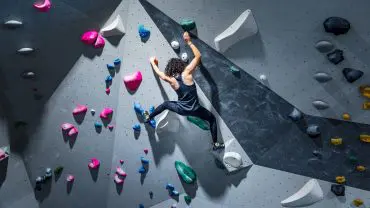Freerunning, also spelled free running, is a form of urban acrobatics in which practitioners use the environment around them to perform tricks and stunts.
It is a sport, a pastime and a performance art. However, for those who practice it, any free running definition would be incomplete without including that it is a form of self expression.
So, what is freerunning and what’s the difference between freerunning vs parkour? What is the free running sport vs philosophy? Let’s jump right in.
What is Freerunning? Free Running Definition

Jumping over a fence in the city during a free running session (Photo: Westend61 via Getty Images)
A major challenge in devising an accurate free running definition is down to the “free” aspect of the sport. And is free running sport, or something else entirely? Some call it performance art, others a way of life or mode of self expression. In his 2008 book on the subject, one of the founders, Sébastien Foucan, called it a cultural phenomenon. So, what is freerunning?
Essentially, freerunning is moving creatively through an urban landscape. From jumps and climbs to flips and tricks, freerunning is characterised by a philosophy of anything goes. The point in freerunning is expression through movement, be it athletic, acrobatic or otherwise.
If that seems a touch vague, fear not. We’re going to delve deeper and the first step is to compare freerunning vs parkour. Why? Because freerunning is an offshoot of parkour. Some even view it as a type of parkour. And comparing the two highlights their main distinguishing features.
What is Freerunning vs Parkour? Shared Origins

Twist and turns (Photo: Slingshot via Getty Images)
Parkour developed in the Parisian suburbs in the 1980s by a group calling themselves the Yamakazi. Inspired by military assault courses, parkour is the challenge of navigating an urban environment, using the obstacles along the way to get from A to B as quickly and efficiently as possible.
That could be jumping between rooftops or vaulting fences, climbing walls or landing in small spaces. But whatever it is, the focus is on speed, deft movements and utilising the urban environment to maximum effect.
Yet, as parkour developed, some practitioners began incorporating other aspects into their movements; acrobatics and flourishes like flips and twists. Moves with no utilitarian function, but plenty of creative flair. Parkour began to split between those who prioritised efficiency, led by Yamakazi leader David Belle, and those who wanted to incorporate self expression and creativity. This latter group, with Sébastien Foucan at the helm, were the creators of freerunning.
Parkour and free running sports have since run alongside one another, with a great deal of overlap. Next, we’ll deal with the specific similarities and differences between freerunning vs parkour.
What is Freerunning vs Parkour? Similarities and Differences

Parkour - A discipline using movement where a person aims to get from one point to another in a complex environment (Photo: Hans Neleman vai Getty Images)
Both freerunning and parkour are disciplines of body movement, traditionally moving within an urban environment. Both are highly social activities with their own cultures and clothing and lexicons. And both share a governing body, the World Freerunning Parkour Association (WFPA).
In terms of freerunning v parkour, the difference is best characterised by their respective focuses. Freerunning is about performance, aesthetics and self expression, while parkour is about overcoming obstacles. Freerunning includes spins and tricks and flips, moves that are purely creative. This is not the case with parkour, where they would be seen as compromising efficiency. Another clear contrast is in terminology. The participants of parkour are called traceurs, while those of freerunning are freerunners.
Beyond this, the distinctions are blurry at best. Some claim that freerunning differs from parkour in that it can be done in rural as well as urban environments. However, there is nothing to prevent parkour in the wild. What’s more, traceurs are often freerunners and vice versa.
Perhaps the most difficult aspect to parse is the philosophical one. Various sources describe each of the activities as the more inclusive or mentally challenging. Some claim one is more competitive than the other. Again, this gets murky.
Free Running Sport

Man performing flip against pillar with footpath, wall with graffiti in the background (Photo: Mike Harrington via Getty Images)
Parkour and free running sport competitions come under the auspices of the WFPA. In terms of free running sport, these competitions tend to judge based on the quality and flow of sequence of moves, much like in gymnastics or dance. Parkour competitions are often based on the speed of negotiating a course of obstacles.
So, what is freerunning? What is freerunning vs parkour and what elements overlap? And is free running sport, art or both? Hopefully you’ve got a much better idea of it all, even if you’re left with the impression that it is far from clear, free and easy.











